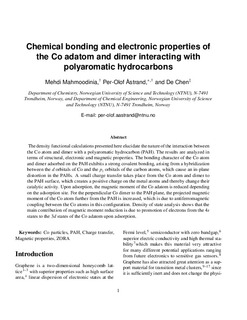| dc.contributor.author | Mahmoodinia, Mehdi | |
| dc.contributor.author | Åstrand, Per-Olof | |
| dc.contributor.author | Chen, De | |
| dc.date.accessioned | 2017-10-27T11:01:03Z | |
| dc.date.available | 2017-10-27T11:01:03Z | |
| dc.date.created | 2015-10-30T13:53:06Z | |
| dc.date.issued | 2015 | |
| dc.identifier.citation | Journal of Physical Chemistry C. 2015, 119 (43), 24425-24438. | nb_NO |
| dc.identifier.issn | 1932-7447 | |
| dc.identifier.uri | http://hdl.handle.net/11250/2462566 | |
| dc.description.abstract | The density functional calculations presented here elucidate the nature of the interaction between the Co atom and dimer with a polyaromatic hydrocarbon (PAH). The results are analyzed in terms of structural, electronic, and magnetic properties. The bonding character of the Co atom and dimer adsorbed on the PAH exhibits a strong covalent bonding, arising from a hybridization between the d orbitals of Co and the pz orbitals of the carbon atoms, which cause an in-plane distortion in the PAHs. A small charge transfer takes place from the Co atom and dimer to the PAH surface, which creates a positive charge on the metal atoms and thereby changes their catalytic activity. Upon adsorption, the magnetic moment of the Co adatom is reduced depending on the adsorption site. For the perpendicular Co dimer to the PAH plane, the projected magnetic moment of the Co atom further from the PAH is increased, which is due to antiferromagnetic coupling between the Co atoms in this configuration. Density of state analysis shows that the main contribution of magnetic moment reduction is due to promotion of electrons from the 4s states to the 3d states of the Co adatom upon adsorption. | nb_NO |
| dc.language.iso | eng | nb_NO |
| dc.publisher | American Chemical Society | nb_NO |
| dc.title | Chemical Bonding and Electronic Properties of the Co Adatom and Dimer Interacting with Polyaromatic Hydrocarbons | nb_NO |
| dc.type | Journal article | nb_NO |
| dc.description.version | submittedVersion | nb_NO |
| dc.source.pagenumber | 24425-24438 | nb_NO |
| dc.source.volume | 119 | nb_NO |
| dc.source.journal | Journal of Physical Chemistry C | nb_NO |
| dc.source.issue | 43 | nb_NO |
| dc.identifier.doi | 10.1021/acs.jpcc.5b07424 | |
| dc.identifier.cristin | 1284892 | |
| dc.relation.project | Norges forskningsråd: 209337 | nb_NO |
| dc.relation.project | Notur/NorStore: nn2920k | nb_NO |
| dc.description.localcode | This is a submitted manuscript of an article published by American Chemical Society in Journal of Physical Chemistry C, October 4, 2015 | nb_NO |
| cristin.unitcode | 194,66,25,0 | |
| cristin.unitcode | 194,66,30,0 | |
| cristin.unitname | Institutt for kjemi | |
| cristin.unitname | Institutt for kjemisk prosessteknologi | |
| cristin.ispublished | true | |
| cristin.fulltext | preprint | |
| cristin.qualitycode | 1 | |
